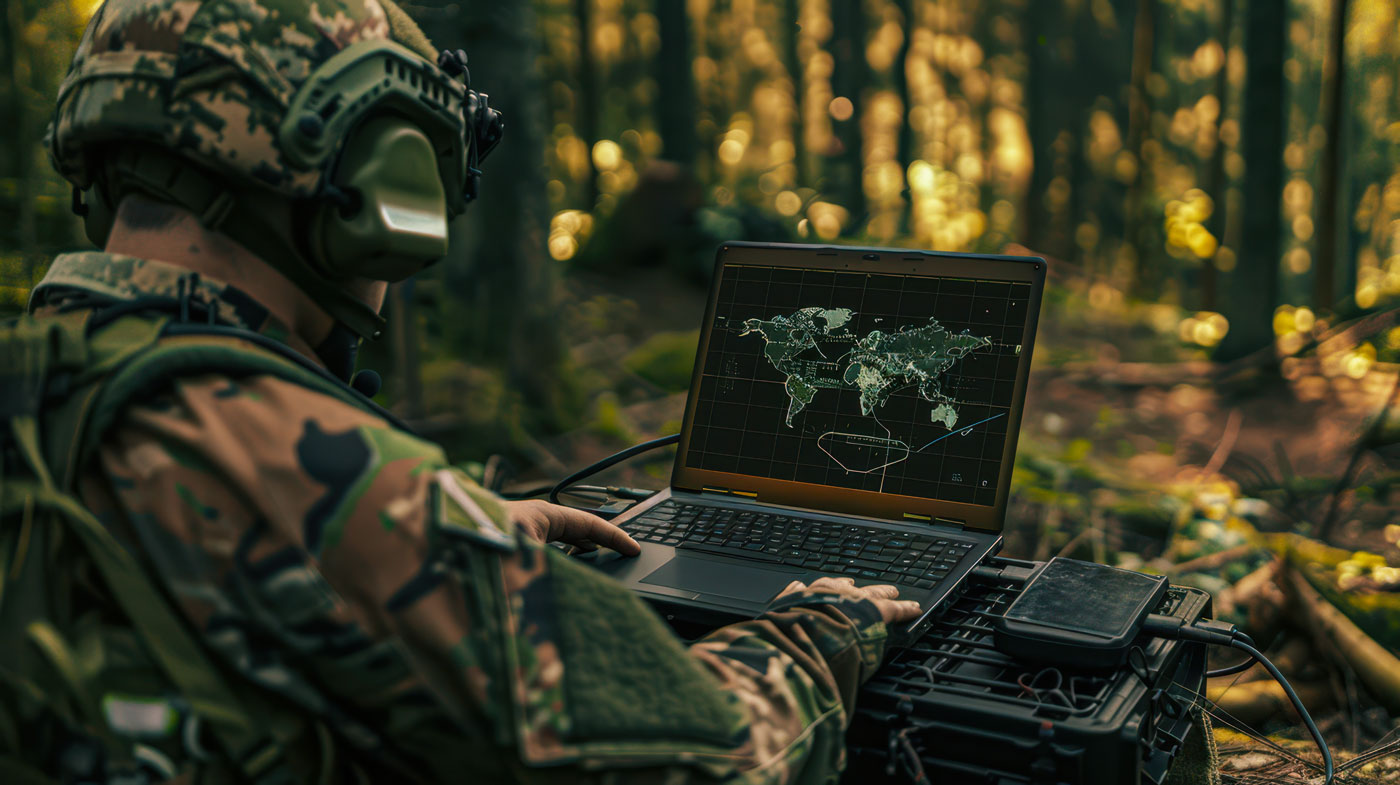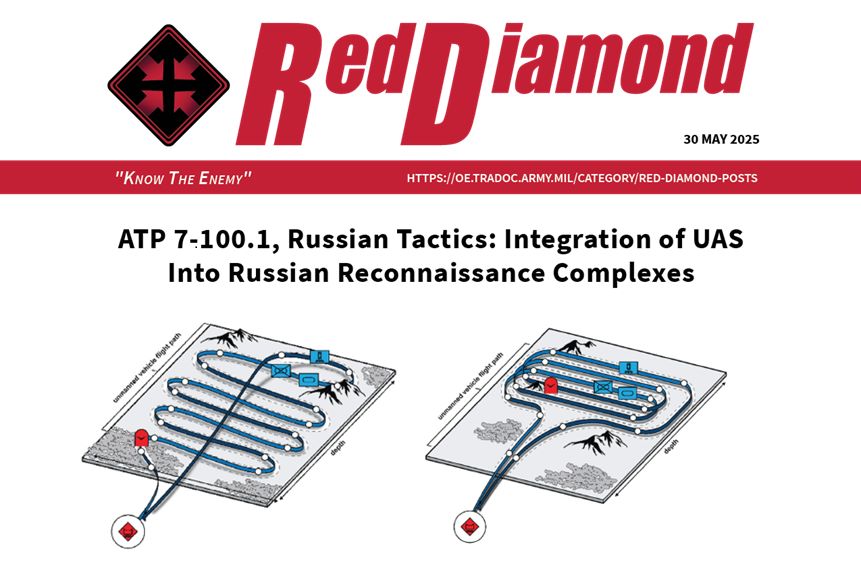
ATP 7-100.1, Russian Tactics: Integration of UAS Into Russian Reconnaissance Complexes
By TRADOC G2
This article will explore how Russian military doctrine incorporates unmanned aerial systems (UAS) into its reconnaissance operations. It will also provide examples of how UAS are tactically employed on the battlefield. The Russian Ground Forces utilize a variety of reconnaissance techniques but have significantly enhanced their capabilities by integrating unmanned aircraft systems for gathering battlefield intelligence.
This article is an excerpt from the February 2024 Army Techniques Publication (ATP), 7-100.1 Russian Tactics, and is part of a series of articles that distill critical concepts from the doctrinal publication into shorter, more digestible pieces. ATP 7-100.1 Russian Tactics is the U.S. Army doctrinal presentation of how Russian ground force doctrine indicates Russian ground forces will approach conflict. This article will examine how Russian doctrine describes the integration of unmanned aircraft systems (UAS) into Russian reconnaissance complexes and introduce examples of tactical employment of UAS. The material is drawn from Chapter 4: Reconnaissance, Chapter 5: Strike, and Appendix C: Reconnaissance of ATP 7-100.1.
The Russian Ground Forces continue using all the reconnaissance techniques available but have significantly expanded their capability to use UAS reconnaissance as a means of gathering battlefield information. Maneuver brigades and divisions employ their organic UAS to support the senior commander’s plan principally focused on supporting target acquisition for indirect fire strikes.
Russian doctrine views the integration of improved sensors from unmanned robotic complexes as critical for increasing the speed and precision of strikes. The use of UAS to provide more precise target identification greatly assists the Russian Ground Forces in responding with more accurate indirect and direct fires. Development programs seek to expand this capability to unmanned ground systems as well as using artificial intelligence to prioritize and direct strikes. Automated and autonomous complexes are currently used by the Russian Ground Forces in tank, air defense, and radio electronic battle (REB) units and subunits to reduce manpower, improve soldier survivability, and rapidly engage aggressor targets.
While the majority of UAS are found in the Ground Forces not the Aerospace Forces, there are development efforts underway to expand UAS capabilities into all Russian military forces. As with ground fire complexes, UAS in the Ground Forces are using established platforms to perform several different functions, reconnaissance, targeting, REB, and direct strikes. The UAS used to support tactical level actions are typically robust and easily transported. They launch either by catapult or by hand and are recovered by parachute or balloon. The Aerospace Forces UAS on the other hand require an airfield for launch and recovery.
Tactical support UAS tie into the Automated Control Systems of the maneuver and artillery units and subunits. Using this link, they can provide real-time battlefield information to automated information system equipped combat vehicles. They are capable of not only communications retransmission over encrypted links but also of forming a common network between multiple platforms.
A UAS flight pattern set to search a designated zone attempts to identify targets or groups of targets in tactical and near operational depths of an aggressor’s combat formation. It serves as a relatively simple method to plan and covers a large area. The main disadvantage is that it exposes the UAS to detection and engagement by aggressor air defenses and can consume a large amount of time depending on the search zone.
The typical flight profiles for the different Russian Ground Forces UAS search patterns as defined in ATP 7-100.1 are depicted below.
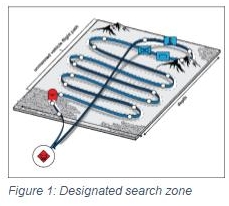 Designated Search Zone. A UAS flight pattern set to search a designated zone attempts to identify group and single targets in tactical and near operational depths of an aggressor’s combat formation. It serves as a relatively simple method to plan and covers a large area. The main disadvantage is that it exposes the UAS to detection and engagement by aggressor air defenses and can consume a large amount of time depending on the search zone.
Designated Search Zone. A UAS flight pattern set to search a designated zone attempts to identify group and single targets in tactical and near operational depths of an aggressor’s combat formation. It serves as a relatively simple method to plan and covers a large area. The main disadvantage is that it exposes the UAS to detection and engagement by aggressor air defenses and can consume a large amount of time depending on the search zone.
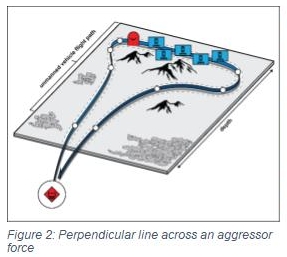 Perpendicular Line Across an Aggressor Force. Using a specified line to fly over a suspected aggressor formation can be highly effective if the selection of the line is refined by other reconnaissance methods during planning. Using REB or counterbattery radars can narrow the search footprint to refine the planned flight path. This pattern is stealthier, allowing the UAS to make a single transit of the suspected line of the targeted aggressor unit. This method reduces the exposure of the UAS to air defense fires. Disadvantages include increased difficulty in transmitting information collected in real-time with any delay causing targeting information to be degraded over time.
Perpendicular Line Across an Aggressor Force. Using a specified line to fly over a suspected aggressor formation can be highly effective if the selection of the line is refined by other reconnaissance methods during planning. Using REB or counterbattery radars can narrow the search footprint to refine the planned flight path. This pattern is stealthier, allowing the UAS to make a single transit of the suspected line of the targeted aggressor unit. This method reduces the exposure of the UAS to air defense fires. Disadvantages include increased difficulty in transmitting information collected in real-time with any delay causing targeting information to be degraded over time.
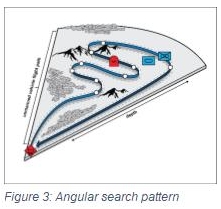 Angular Search Pattern. The search of an angular sector orients the UAS on an angular search zone. The planning and selection of the search zone can be based on a likely march route of an aggressor force that is limited by terrain or other mobility factors. This method is particularly effective when there is no continuous line of contact between SV units and a targeted aggressor.
Angular Search Pattern. The search of an angular sector orients the UAS on an angular search zone. The planning and selection of the search zone can be based on a likely march route of an aggressor force that is limited by terrain or other mobility factors. This method is particularly effective when there is no continuous line of contact between SV units and a targeted aggressor.
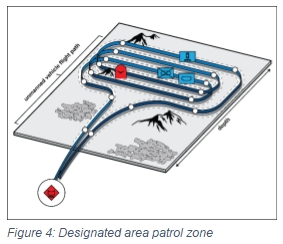 Designated Area Patrol Zone. Continuous patrol of a designated area is best accomplished by a long-duration UAS with side-looking radar or electro-optical sensors. These characteristics allow the UAS to observe a search zone
Designated Area Patrol Zone. Continuous patrol of a designated area is best accomplished by a long-duration UAS with side-looking radar or electro-optical sensors. These characteristics allow the UAS to observe a search zone
without entering the air defense zone of the aggressor unit. It is not a particularly stealthy flight pattern with repetitive tracks in a relatively restricted airspace. Predictable patterns and sensor emanations increase the platform’s vulnerability to aviation or antiradiation missiles.
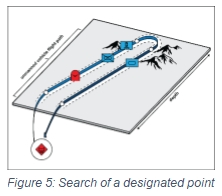 Search of a Designated Point. Reconnaissance of a specific point is used when the coordinates of a target are known to confirm its status. Coverage of choke points such as bridges or other defiles or confirmation of signals intelligence locations for C2 complexes are examples of designated points. This method provides the greatest stealth and least exposure to aggressor air defenses. Its main disadvantage is that it provides a very limited amount of information.
Search of a Designated Point. Reconnaissance of a specific point is used when the coordinates of a target are known to confirm its status. Coverage of choke points such as bridges or other defiles or confirmation of signals intelligence locations for C2 complexes are examples of designated points. This method provides the greatest stealth and least exposure to aggressor air defenses. Its main disadvantage is that it provides a very limited amount of information.
 Designated Flight Route Search. A flight path to search a given route may be used when there is information about the location of an aggressor unit or group of targets whose movement routes are constrained by terrain. It uses a low altitude high-speed flight profile to search designated waypoints on the route.
Designated Flight Route Search. A flight path to search a given route may be used when there is information about the location of an aggressor unit or group of targets whose movement routes are constrained by terrain. It uses a low altitude high-speed flight profile to search designated waypoints on the route.
The Russian Ground Forces have expanded the use of small UAS during the so-called “Special Military Operation” in Ukraine. Russian Ground Forces have demonstrated a capability to refine the reconnaissance-strike and reconnaissance-fires complexes.1 Russian forces use UAS to identify priority targets for engagement with traditional mass or precision fires. Russia has used reconnaissance-strike and reconnaissance-fires complexes cross-queued by other sensors to target high-value weapons systems, such as HIMARS, in Ukraine.2
Notes
1 Battersby, Blair. 2023. Review of Remedies for the Missing Links in Russia’s Kill Chain. Red Diamond, December. https://oe.tradoc.army.mil/category/red-diamond-posts/.
2 Harward, Christina, Riley Bailey, Nicole Wolkov, Grace Mappes, and George Barros. 2024. “Institute for the Study of War.” Institute for the Study of War. July 7, 2024. https://www.understandingwar.org/backgrounder/russian-offensive-campaign-assessment-july-7-2024.
Distribution A: Approved for public release
Categories:
Tags:
ATP 7-100.1, Russian Tactics: Integration of UAS Into Russian Reconnaissance Complexes
By TRADOC G2
File Size:
947KB
File Type:
Page Count:
4


